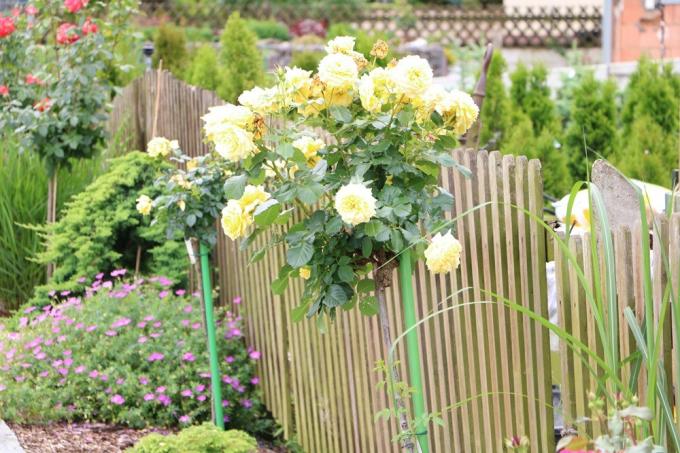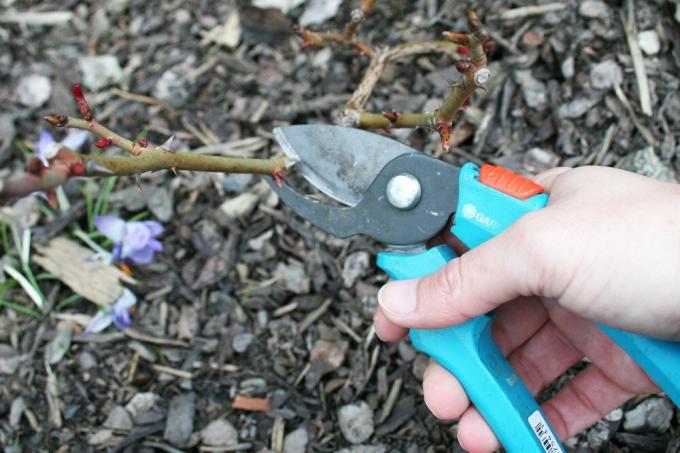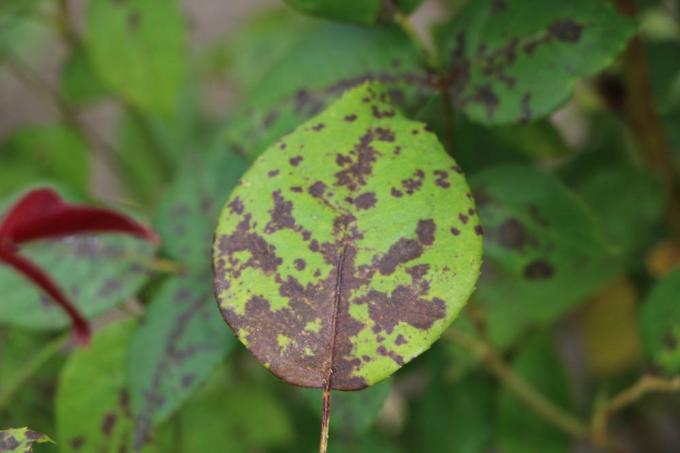
table of contents
- Characteristics
- Location
- Soil and tub substrate
- Plant in the bed
- Plant in the tub
- Fertilize
- to water
- Cut
- Diseases and pests
Profile and care information open +conclude -
- Flower color
- yellow, multicolored, orange, pink, red, white
- Location
- Partial shade, shady, sunny
- Heyday
- May, June, July, August, September, October, November
- Growth habit
- upright, creeping
- height
- up to 160 cm high (rarely higher)
- Soil type
- loamy
- Soil moisture
- moderately moist, fresh
- PH value
- neutral, slightly acidic
- Limescale tolerance
- Calcium tolerant
- humus
- rich in humus
- Poisonous
- no
- Plant families
- Rose family, Rosaceae
- Plant species
- Ornamental plants, bedding plants, container plants
- Garden style
- Ornamental garden, potted garden, cottage garden, cottage garden
The care of standard roses is the supreme discipline for hobby gardeners. An optimal location alone is not enough to showcase the queen of flowers as a picturesque rose stem. Proper planting, fertilizing, watering and cutting round off successful cultivation perfectly. It is important to note important differences in comparison with classic bed and shrub roses. This green guide will familiarize you with the flawless process of caring for high-stem roses from A-Z. A beginner's guide explains when and how to cut rose stems in an exemplary manner.
Characteristics
- Plant family: Rosaceae
- Genus: Roses with 100 to 250 species and countless varieties
- Growth: deciduous flowering wood with upright, creeping or climbing shoots
- Standard roses: rose varieties refined on a wild base and stem
- Trunk height: 60 to 90, 140 to 160 cm, rarely lower or higher
- Flowering period: May to November (single-flowered and multiple-flowered varieties)
- Location: sunny, shady to partially shaded, warm and sheltered from the wind
- Soil quality: deep, permeable, nutrient-rich, pH value 6.0 to 7.0
- Winter hardiness: suitable for winter hardiness zones Z5 (- 23.3 ° to - 28.8 °) and Z4 (- 28.9 ° to - 34.4 °)
- Limescale tolerance: good
- Toxic: no, risk of injury from spikes
- Special feature: refinement point at the base of the crown
In principle, every garden rose is suitable for cultivation as a rose stem. Flowering ground cover roses, such as the popular varieties 'Knirps' and 'Gärtnerfreude', the nostalgic bed roses' Leonardo da Vinci 'and' Snowflake 'as well as the legendary hybrid tea rose' Gloria Dei ‘. Climbing roses celebrate an opulent flower fairy tale when they are refined on a sturdy stem. The deep pink flowering variety 'Rosarium Uetersen' inspires as a cascade strain just as much as the famous, white flowering 'Alba Meidiland', whose train-like crown growth attracts everyone's attention.
Location

All standard roses are sun children. A sunny location promotes healthy growth and an abundance of flowers. Furthermore, the sun's rays allow wet leaves to dry off more quickly, which significantly reduces the pressure of fungal infections. Admittedly, a rose stem should not be located in front of the sizzling, hot south facades. There is a risk of irreversible leaf damage due to reflected radiation, which does not even spare the underside of the leaf. Choose a location with these ideal framework conditions:
- sunny to partially shaded location with at least 4 to 6 hours of sunshine a day
- warm, sheltered location
- ideally under an awning or canopy as rain protection
Roses grafted on a high trunk are equally suitable for planting in beds and tubs. In potted cultivation, please pay particular attention to a location that is calm in the wind, in order to avoid the risk of windthrowing.
Soil and tub substrate
The sturdy game underlay stretches out its roots in the ground or in the bucket substrate. From here the noble crown is supplied with water and nutrients. The optimal rose soil should have the following properties:
- in the bed: deep, fresh and moist, well drained and rich in nutrients
- in the bucket: loosely humic, with reliable water drainage, without peat content
- ideal pH value in the soil and pot substrate: 6.5
Like all roses, standard roses also thrive as deep roots. So that the long taproots can develop unhindered, we recommend a location in the bed with a 40 to 50 centimeter layer of roots that can be penetrated. A bucket that is at least 50 centimeters high offers the root ball a sufficiently large volume.
Note soil fatigue
Roses are particularly affected by soil fatigue. This is a phenomenon that can often be observed in gardening practice without knowing the actual causes. Characteristic of soil fatigue are short stature and blooming rottenness when new roses are planted on areas that were previously covered with rose plants.
To avoid the negative symptoms, there are two options to choose from. Rotating crops for four to five years is the best course of action. Specifically, this means that between planting roses, you insert a bridging phase of several years with plants from another family. Alternatively, a soil exchange from 50 to 100 centimeters deep prevents new specimens from suffering from soil fatigue in a seamless rose cultivation.
Plant in the bed

The best time to plant standard roses in the bed is autumn when the soil is warm in the sun. Since rose stems are usually available as container plants, the time window for planting is open throughout the year, provided there is no freezing or summer drought. Rake the soil thoroughly until a finely crumbly, weed-free structure is formed. Before you start planting, soak the root ball in water for 12 to 24 hours. How to properly plant a standard rose in the bed:
- Dig a planting pit with 1.5 times the volume of the root ball
- Enrich the excavation to a third with compost and horn shavings
- Caution: do not add any mineral fertilizer to the planting pit
- Pot the water-soaked root ball and position it in the middle of the pit
- Plant the root ball up to the point of the cones (thickening at the base)
- Put a sturdy support post in the ground next to the rose stem
- Connect post and high trunk with figure eight loops
- Cut back all shoots to a length of 10 to 15 cm
Tread on the soil and water generously without waterlogging. A thick layer of mulch made of straw, leaves and coniferous branches protects the fresh planting area from wintry moisture and severe frost. In the last step of planting, cover the crown with breathable fleece, which you tie down at the base of the crown below the refinement point. The primary task of this hood is to protect the noble rose crown, including the sensitive finishing area, from drying out due to the sun and wind. The water supply takes on a key function so that standard roses take root in the location. After planting, water regularly until the rose has sprouted at least 10 centimeters.
Plant in the tub

The best time to plant standard roses in the tub is in April and May. In order for the demanding flower beauties to develop magnificently in the limited substrate volume, important differences must be observed in comparison with a bed planting. How to complete planting in the tub in an exemplary manner:
- Create a 5 cm thick drainage made of potsherds, gravel or expanded clay balls on the bottom of the pot
- Cover the drainage with a water- and air-permeable fleece
- Fill the bucket with substrate halfway up
- Pot the water-soaked root ball and plant up to the point of the cones
- Caution: Spread the roots straight and do not compress
- Recommended: pouring edge of 3 to 5 cm
- Press the substrate on with both hands
- Pour in until the water runs out of the bottom opening
- Shorten all branches to 10 to 15 cm
A wooden post serves as a support and should reach into the crown. Soft hose ties or wide jute ribbons, which do not grow into the young bark as quickly, are suitable as binding material. Evaporation protection is just as advisable in spring as in autumn. With a hood made of fleece, jute or fir branches, you can protect the young rose crown from drought stress caused by wind and sun. At the same time, you take away the horror of belated frosts.
Fertilize
In the near-natural care of rose stems in the bed, home gardeners give preference to organic fertilizers. The supply of organic nutrients in the form of compost, bark humus or horse manure reliably prevents the dangers of overfertilization and nutrient deficiency. For gardeners without a compost heap, specialist retailers have packaged, organic fertilizers ready, such as Oscorna Animalin. Excess nitrogen is detrimental to the health and flowering potential of roses. This is why ecologically oriented gardeners have banned artificial mineral fertilizers such as blue corn from the garden. Special rose liquid fertilizers for potted plants are a combination of mineral and organic components with a low-nitrogen NPK formulation. Standard roses benefit from this supply of nutrients in beds and buckets:
- Do not fertilize freshly planted rose stems until the end of June
- in later years fertilize every 4 weeks from March to July
- In the bed: work in ripe compost, bark humus or Oscorna Animalin on the surface and pour in
- in the bucket: add liquid rose fertilizer to the irrigation water, according to the manufacturer's instructions
From the end of July, please stop fertilizing so that rose shoots ripen before the first frost. Winter hardiness is naturally strengthened if you give a potassium-based fertilizer, such as comfrey manure, in July.
to water
Roses respond to drought stress by shedding buds, flowers and leaves. In summer, check the water requirements of the soil and substrate daily in the early morning or after sunset with a finger test. To do this, press your fingertip 1 to 2 centimeters into the soil. If you do not feel any moisture, there is a need to water. So that wet rose petals do not attract fungal spores or pests, please water with the watering can. Let the normal tap water run directly onto the root disc until the soil is saturated. The thirst of potted plants is quenched when the saucer fills up. Regulate the water balance of your standard roses according to the rule of thumb: it is better to water infrequently and thoroughly than often and little.
Cut

In the rose care program, expert pruning is a headache for most hobby gardeners. The following instructions have made it their business to remove all doubts about the successful pruning of rose stems. How to cut a rose on a stem correctly:
- the best time is in spring when the forsythia is in bloom
- Recommended cutting tool: bypass secateurs or special rose shears
- Put on thorn-proof gloves with long cuffs
- Cut off damaged, frozen or dead branches at the roots beforehand
- Shorten the remaining shoots to 3 to 5 buds
- Start the cut at a slight angle 3 to 4 mm above a bud
The specific circumference of the cut takes into account the type of rose and the growth rate. You only prune a vigorous rose crown a little, because too massive a cut causes the growth of unstable long shoots. In this case, leave 5 to 7 buds. A weak rose crown should be cut back down to 2 to 3 buds to encourage vital budding. It is important to note that you do not cut into the finishing points at the base of the crown.
Clean up and remove wild shoots
In addition to the shape and maintenance pruning in spring, the rose shears are used repeatedly during the summer. Cut off dead flowers on the peduncle above the first leaf. At this point, a fresh bud can usually be seen, which now has free access to sunlight. The only exception rule applies to rose varieties that have decorative rose hips in autumn and winter.
If you dedicate yourself to cleaning out withered rose blossoms, you also check your standard rose for wild shoots. Various rootstocks constantly sprout sterile shoots from the rootstock and trunk in order to overgrow the noble rose crown. You can identify blind shoots on smaller leaves and denser thorns. On the rhizome, tear out the cheeky shoots with a brave jerk to remove all tissue remnants. Cut off each wild shoot on the trunk as close as possible to the bark.
Diseases and pests

Disease control is a big issue in the care of all roses, including rose stems. The best protection against fungal infections is cultivation under the best possible framework conditions. In the early stages, gardening practices have shown natural pesticides to be effective. In the following, we briefly present common rose diseases with typical symptoms and tips for treatment and prevention:
Rose rust (Phragmidium mucronatum)
Characteristic symptoms of rose rust are bright orange pustules on the undersides of the leaves and yellowish-brown spots on the upper sides that appear from early summer. Leaf fall is usually associated with the infection. This is how treatment and prevention work:
- Completely remove infected leaves and dispose of with household waste
- Early stage: repeatedly spraying the infected rose with horsetail broth or liverwort extract
- advanced stage: Fungisan give rose and vegetable mushrooms free according to the manufacturer's instructions
- As a preventive measure, do not pour over the leaves and fertilize with an emphasis on potassium
Star soot (Diplocarpon rosae)
The stubborn and dreaded fungal infection hardly spares a rose. Black spots appear on the leaves in the form of black spots, which can appear as early as April and May in cold and wet weather. As the process progresses, the spots spread, the leaves turn yellow and fall off. Strong infestation pressure leaves a completely defoliated standard rose in midsummer. How to fight the disease:
- remove and destroy all affected leaves
- early stage of infestation: fortify rose with horsetail, comfrey stock or garlic broth
- advanced stage: spray Duaxo rose mushroom-free or Saprol rose mushroom-free
- Plant resistant standard roses as a preventive measure, do not leave any leaves in the bed, do not water overhead
Powdery mildew (Sphaerotheca pannosa var. rosae)
Powdery mildew should be mentioned as the third member of the group of common diseases on rose stems. The widespread fungal disease is easy to identify from a floury coating on leaves and shoots. While affected rose gardeners are mostly lost when it comes to rose rust and star soot, a home remedy has proven itself in the fight against powdery mildew. How to treat the standard roses against powdery mildew:
- Cut infected parts of the plant back into the healthy wood
- Destroy clippings and do not throw them on the compost
- Make sprays from 1 liter of boiled water and 1/8 to 1/4 liter of fresh milk
- Spray the rose crown every 3 days so that it is dripping wet

